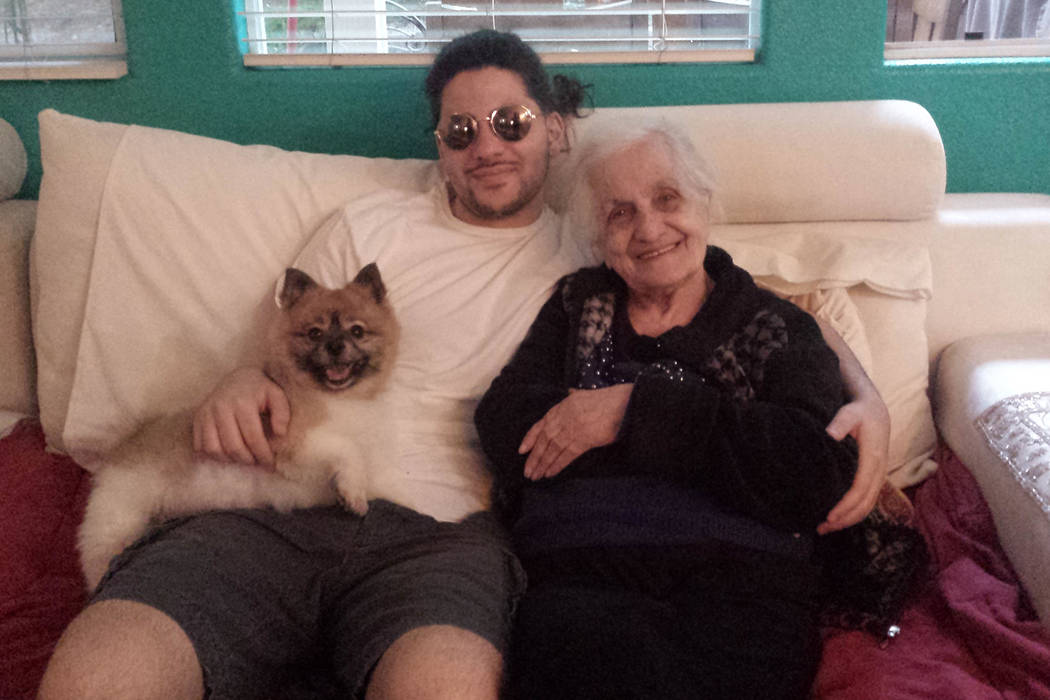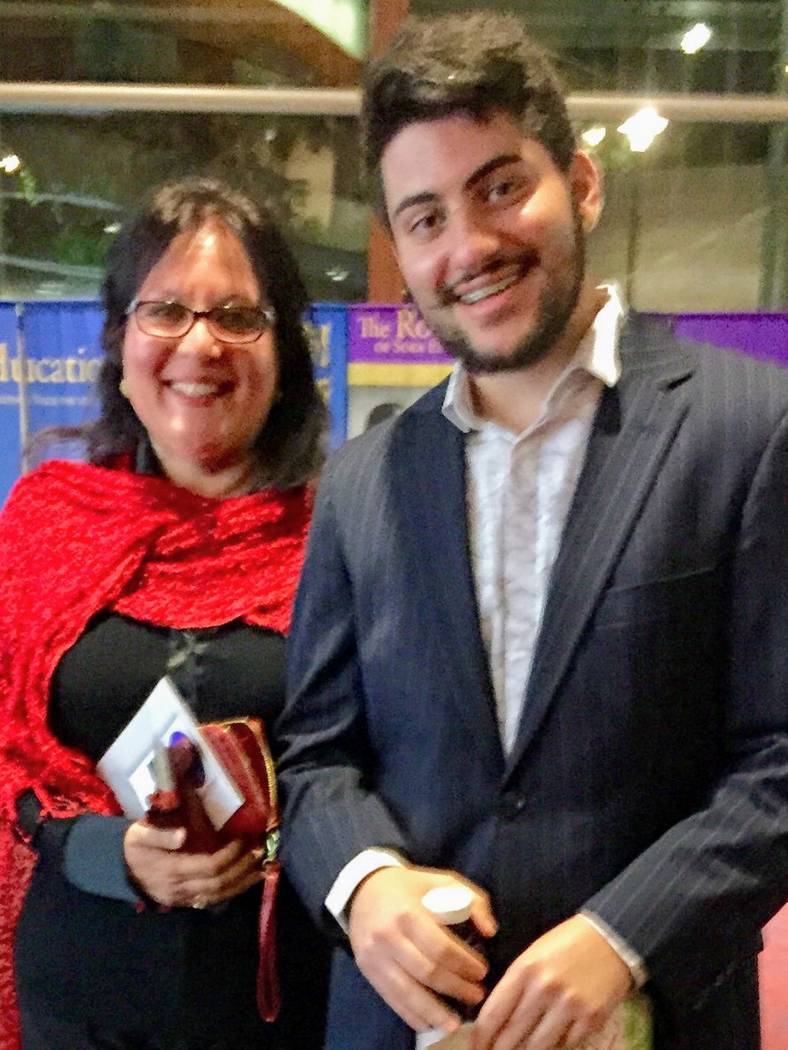Myasthenia gravis resources are rare, Las Vegas patient finds
Aarash Taghdir knew something was wrong when he began to experience double vision and such severe fatigue that his body would force him to take secret naps at work.
Taghdir, 26, noticed the first mysterious symptoms toward the end of high school in 2010. It was’t until early 2018 that he was diagnosed with myasthenia gravis by a doctor in Southern California.
Myasthenia gravis is a chronic autoimmune neuromuscular disorder affecting muscles that move voluntarily. Patients often have problems moving their eyes or holding their eyelids open; they may have problems chewing, talking and swallowing. The neck and other limbs may also be affected.
Autoimmune diseases occur when the body’s immune system mistakenly attacks and destroys its own special proteins on the muscle surfaces, according to a handbook from the Myasthenia Gravis Foundation of California. Nevada doesn’t have a similar statewide grassroots group.
Dr. James Howard Jr., a distinguished professor of neuromuscular disease and professor of neurology and medicine at the University of North Carolina School of Medicine, said MG patients can experience symptoms as mild as an eyelid droop and severe enough to require a respirator.
Symptoms can be worsened by infection and by a patient using medication known to aggravate the disease, Howard said.
The disease is rare, only affecting 20 in 100,000 Americans, according to the Myasthenia Gravis Foundation of America.
‘Totally lost and confused’
Taghdir became too fatigued to keep up with school and work, and he withdrew from both. MG patients sometimes struggle with speaking; the Las Vegas Review-Journal interviewed Taghdir via text message.
After attending Rancho High School and graduating from Palo Verde, Taghdir tried to work at multiple jobs. His MG symptoms proved too disruptive, he said.
Taghdir said one of the most difficult elements of the little-known disease is that the symptoms are all under the surface. Taghdir looked like a typical mid-20-something when he was diagnosed, he said.
“I am totally lost and confused and suffering and desperate and feeling like the essence of life is being taken from me constantly,” he said. “And one of the most confusing things is how I would seem more normal one second and feel as if all of these symptoms couldn’t have existed … but without warning there they were again.”
Taghdir’s mother, Firouzeh Forouzmand, said that when he began feeling the symptoms in his eyes, she took him to multiple doctors in Las Vegas. No one found anything physically wrong with him. One doctor believed Taghdir had psychosis — a mental disorder that disconnects the sufferer from reality.
Taghdir and his mother eventually went to a doctor in Los Angeles who diagnosed him with MG.
Support in Las Vegas
Forouzmand found the Myasthenia Gravis Support Group of Las Vegas, which met at Spring Valley Library. After attending her first meeting, Forouzmand sat in the library parking lot and cried, wondering, “Why him?”
She said meeting attendees kept telling her, “Your son is so young.”
People of any age can experience the onset of MG, according to the Myasthenia Gravis Foundation of California.
The Las Vegas support group, a chapter of the Myasthenia Gravis Foundation of California, now meets at West Charleston Library. Forouzmand, the coordinator of the library’s Performing Arts Center, helped get it moved there. Meetings are held on various Saturdays every other month. Dates can be found via West Charleston Library’s web page at lvccld.org/locations/WC.
At the group’s Jan. 5 meeting, about 12 MG patients and their caretakers discussed the challenges of losing relationships with family members and friends who misunderstand the disease. Attendees didn’t share their full names.
A couple discussed the struggles that MG patients’ spouses often face. Several others said they’ve seen marriages break up because loved ones often don’t understand how to help their spouse.
Taghdir, who did not attend the meeting, said he often felt ignored by his family.
Forouzmand said Taghdir was active and interested in health, and got frequent compliments on his eyes. Today he no longer exercises for long periods and wears sunglasses.
“I don’t get to see his beautiful eyes,” Forouzmand said.
Taghdir said he wears sunglasses because, “It’s tough explaining the lack of personal connection [that comes with] eye contact when you have one eye that is completely uncooperative.”
Impediments to treatment
The lack of doctors in Las Vegas who specialize in MG diagnosis and treatment frustrated Forouzmand and Taghdir.
Another frustration is the cost of treatment. At 26, Taghdir is no longer eligible to be insured under his mother’s plan. Because he cannot work, they must pay out of pocket for all medical expenses.
Taghdir also stays on a strict autoimmune protocol diet and takes supplements to help with his symptoms, a lifestyle he said is “hard to afford.”
The Federal Drug Administration approved the first treatment exclusively for MG in October 2017, Howard said.
He added that few neuromuscular experts specialize in MG.
“Regrettably, the knowledge base is not where we would like it,” Howard said. “It is a rare disease and so one’s exposure is limited. As a result, the patient has to become their best advocate.”
As a result, online research and support groups can be the best resources for MG patients and those who think they might have the disease, Howard said.
Taghdir said hope is important in coping with MG.
“I think love from those around you is very important,” he said. “I think getting yourself to a place where you can rest and have peace and sustenance is important.”
Contact Rachel Spacek at 702-387-2921 or rspacek@reviewjournal.com. Follow @RachelSpacek on Twitter.
Resources
Myasthenia Gravis Support Group of Las Vegas: Call Firouzeh Forouzmand at West Charleston Library at 702-507-3964.
Myasthenia Gravis Foundation of California: myasthenia-ca.org
Myasthenia Gravis Foundation of America: myasthenia.org































